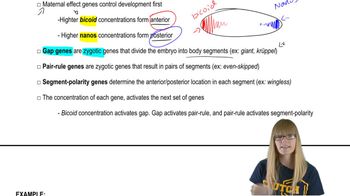Compare and contrast the specification of segmental identity in Drosophila with that of floral organ specification in Arabidopsis. What is the same in this process, and what is different?
Table of contents
- 1. Introduction to Genetics51m
- 2. Mendel's Laws of Inheritance3h 37m
- 3. Extensions to Mendelian Inheritance2h 41m
- 4. Genetic Mapping and Linkage2h 28m
- 5. Genetics of Bacteria and Viruses1h 21m
- 6. Chromosomal Variation1h 48m
- 7. DNA and Chromosome Structure56m
- 8. DNA Replication1h 10m
- 9. Mitosis and Meiosis1h 34m
- 10. Transcription1h 0m
- 11. Translation58m
- 12. Gene Regulation in Prokaryotes1h 19m
- 13. Gene Regulation in Eukaryotes44m
- 14. Genetic Control of Development44m
- 15. Genomes and Genomics1h 50m
- 16. Transposable Elements47m
- 17. Mutation, Repair, and Recombination1h 6m
- 18. Molecular Genetic Tools19m
- 19. Cancer Genetics29m
- 20. Quantitative Genetics1h 26m
- 21. Population Genetics50m
- 22. Evolutionary Genetics29m
14. Genetic Control of Development
Developmental Patterning Genes
Problem 12
Textbook Question
The homeotic mutation Antennapedia causes mutant Drosophila to have legs in place of antennae and is a dominant gain-of-function mutation. What are the properties of such mutations? How does the Antennapedia gene change antennae into legs?
 Verified step by step guidance
Verified step by step guidance1
Understand the concept of homeotic mutations: These are mutations in genes that control the development of body structures, causing one body part to develop as another. In this case, the Antennapedia mutation causes legs to form in place of antennae.
Recognize that Antennapedia is a dominant gain-of-function mutation: Gain-of-function mutations result in a gene acquiring a new or enhanced activity. Dominance means that only one copy of the mutated gene is sufficient to cause the phenotype.
Learn about the role of homeotic genes: Homeotic genes, such as Antennapedia, are part of the Hox gene family. These genes encode transcription factors that regulate the expression of other genes, determining the identity of body segments during development.
Explore how the Antennapedia gene functions: In the mutant Drosophila, the Antennapedia gene is misexpressed in the head region where antennae normally develop. This misexpression leads to the activation of leg-specific developmental pathways in the head, replacing antennae with legs.
Understand the mechanism of misexpression: The mutation likely alters the regulatory elements of the Antennapedia gene, causing it to be expressed in the wrong location (the head instead of the thorax). This ectopic expression drives the development of legs in place of antennae.
 Verified video answer for a similar problem:
Verified video answer for a similar problem:This video solution was recommended by our tutors as helpful for the problem above
Video duration:
2mPlay a video:
Was this helpful?
Key Concepts
Here are the essential concepts you must grasp in order to answer the question correctly.
Homeotic Genes
Homeotic genes are crucial for determining the identity of body segments in organisms. They encode transcription factors that regulate the expression of other genes, guiding the development of specific structures in the correct locations. In Drosophila, mutations in these genes can lead to dramatic changes in morphology, such as the transformation of antennae into legs.
Recommended video:
Guided course

Segmentation Genes
Gain-of-Function Mutations
Gain-of-function mutations result in a gene product with enhanced or new functions. In the case of the Antennapedia mutation, the altered gene product leads to the inappropriate activation of leg development pathways in the head region, causing legs to form instead of antennae. These mutations can be dominant, meaning that only one copy of the mutated gene is sufficient to produce the phenotype.
Recommended video:
Guided course

Functional Genomics
Transcriptional Regulation
Transcriptional regulation involves the control of gene expression at the transcription level, determining when and how much of a gene product is made. In the context of the Antennapedia mutation, the altered regulation allows for the expression of leg-specific genes in the antennae region, effectively reprogramming the developmental fate of those structures. This process is critical for understanding how mutations can lead to significant morphological changes.
Recommended video:
Guided course

Eukaryotic Transcription
Related Videos
Related Practice
Textbook Question
490
views


